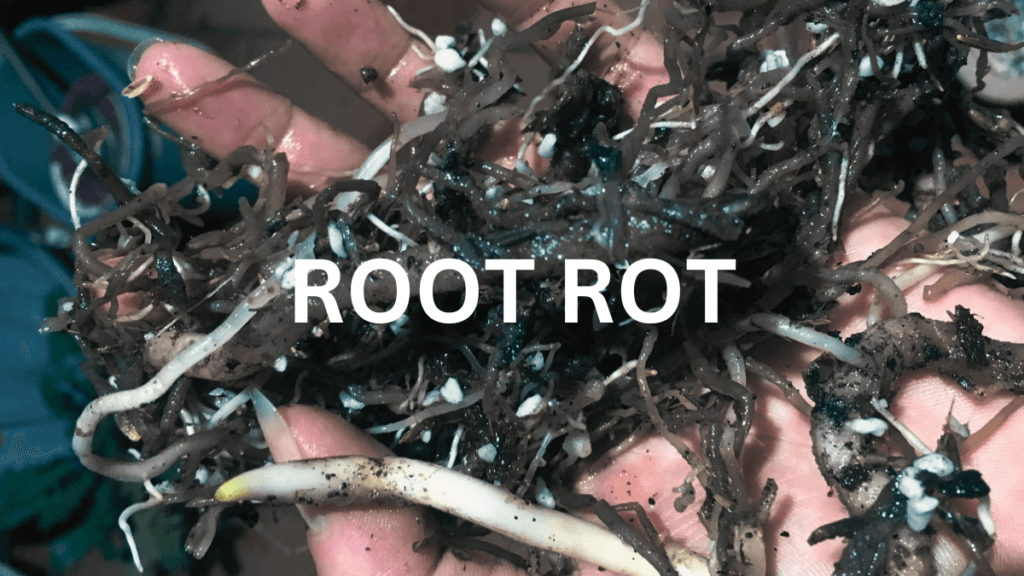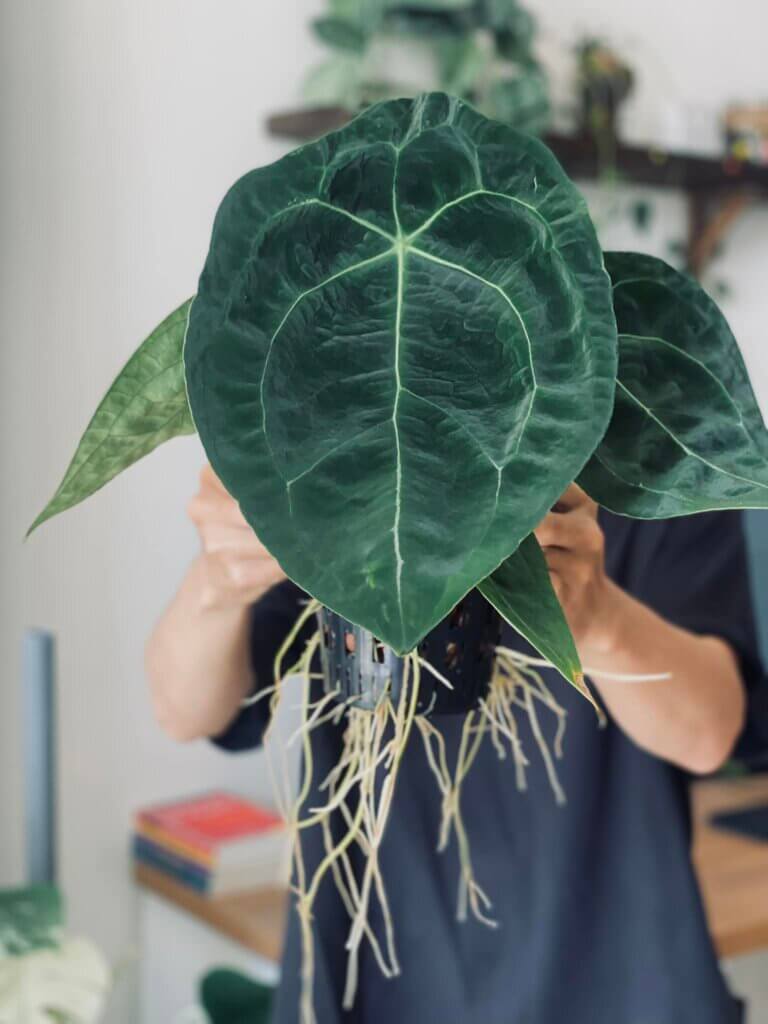Have you ever seen your beloved houseplant wilt and fade, despite your best efforts? Often, the culprit is root rot, a common yet devastating issue for plant enthusiasts.
But fear not, there’s a ray of hope: semi-hydroponics. This innovative approach might just be the answer you’re looking for.
Summary
Root Rots On Houseplants
- Root Rot Issue: A serious problem in houseplants, often due to overwatering and poor drainage.
- Symptoms: Yellowing leaves, wilting, stunted growth, soft brown roots, foul soil smell.
- Prevention Strategies:
- Proper Watering: Only when the topsoil is dry.
- Well-Draining Pots: Essential for excess water escape.
- Suitable Soil Mix: Using a mix like peat, pine bark, and perlite.
- Regular Root Checks: Inspect and trim rotten roots during repotting.
- Environmental Control: Maintain adequate humidity and proper lighting.
- Fungicides: Use preventative fungicides in some cases.
- Monitor Plant Health: Look for early stress signs.
- Semi-Hydroponics Benefits:
- Improved Aeration: Prevents anaerobic conditions.
- Controlled Moisture Levels: Reduces overwatering risk.
- Transparent Containers: Allows for visual monitoring of root health.

What is Root Rot?
Root rot is a disease that attacks the roots of plants, causing them to decay. It’s a silent killer, often unnoticed until it’s too late.
Root rot is more than just a simple plant ailment; it’s a complex disease that can spell disaster for indoor plants. This condition occurs when the roots of a plant start decaying due to excessive moisture. Typically unseen beneath the soil or growth medium, root rot stealthily undermines the health of the plant.
Causes of Root Rot
Root rot primarily occurs due to overwatering.
In a traditional soil setup, excess water limits oxygen supply to the roots, creating an environment ripe for harmful fungi and bacteria. Poor drainage and compacted soil exacerbate this issue.
At its core, root rot is caused by a lack of adequate oxygen reaching the plant’s roots.
In a healthy plant, roots access oxygen, which is as crucial for them as it is for the above-ground parts of the plant. When the roots are submerged in water for prolonged periods, this oxygen supply is cut off. This environment is not just unfavorable for the roots but also becomes a breeding ground for fungi and bacteria that thrive in waterlogged conditions.
Signs to Watch Out For
Root rot can be a bit of a sneak thief, quietly damaging your plants before you even realize there’s a problem. To catch it early, keep an eye out for these tell-tale signs:

- Yellowing Leaves: One of the first signs is a change in leaf color. Leaves may start turning yellow, often beginning at the tips and edges.
- Wilting: Despite regular watering, your plant may appear wilted or droopy. This is a reaction to the damaged, non-functional roots.
- Stunted Growth or Leaf Drop: If your plant stops growing or starts shedding leaves more than usual, it could be a distress signal.
- Soft, Brown Roots: Upon inspecting the roots, healthy ones should be firm and white. Rotten roots, however, will be soft, brown, or black, and may have a slimy texture.
- Foul Smell from Soil: A musty or rotten odor emanating from the soil is a strong indicator of root rot.
- Mold or Fungus on Soil Surface: Sometimes, you might notice mold or a fungal growth on the soil surface, signaling unhealthy conditions below.
- Waterlogged Soil: Consistently soggy or waterlogged soil is a precursor to root rot.
- Dark Spots or Lesions on Roots: As the rot progresses, you might find dark, decayed spots or lesions on the roots.
- Leaf Edema: Swollen, blister-like patches on the leaves, resulting from water retention, can be an indirect symptom of root rot.
- Soft, Mushy Stem Base: In advanced stages, the base of the stem may become soft and mushy, a sign of rot spreading upwards.
Identifying these symptoms early is crucial for saving your plant. The sooner you detect root rot, the better your chances of rescuing your plant and preventing the disease from spreading.
How to Prevent Root Rot in Houseplants
Root rot can be a significant challenge for houseplant enthusiasts. However, with the right practices, you can prevent this issue and maintain healthy plants. Here’s a guide on how to prevent root rot:
- Proper Watering Techniques
- Water Judiciously: Overwatering is a primary cause of root rot. Ensure you water your plants only when needed. The topsoil should be dry to the touch before watering again.
- Use Well-Draining Pots: Choose pots with drainage holes to allow excess water to escape. This prevents water from accumulating at the bottom and creating soggy conditions.
- Read more: How to water Houseplants properly
- Appropriate Soil Mix
- Well-Draining Soil: Use a soil mix that drains well and doesn’t retain excessive moisture. A mix of peat, pine bark, and perlite often works well for most houseplants.
- Avoid Soil Compaction: Loosen the soil periodically to prevent compaction, which can impede drainage and aeration.
- Regular Root Checks
- Inspect Roots During Repotting: When repotting, take the opportunity to inspect the roots. Healthy roots are typically white and firm.
- Trim Rotten Roots: If you notice any brown, mushy roots, trim them off with sterile scissors or pruners.
- Environmental Control
- Maintain Adequate Humidity: Ensure your plants are in an environment with suitable humidity levels. Too much humidity can contribute to damp conditions conducive to root rot.
- Proper Lighting: Adequate lighting helps the soil dry out more effectively and promotes overall plant health.
- Use of Fungicides
- Preventative Fungicides: In some cases, using a fungicide can help prevent root rot, especially in environments prone to fungal growth.
- Monitor Plant Health
- Watch for Early Signs: Regularly check your plants for early signs of stress, such as yellowing leaves or stunted growth, which can be indicators of root rot.
- Consider Alternative Growing Methods
- Semi-Hydroponics: Semi-hydroponic systems can significantly reduce the risk of root rot by ensuring a balance of water and air around the roots.
Preventing Root Rot with Semi-Hydroponics
Semi-hydroponics offers an innovative solution to the common problem of root rot in houseplants. This method effectively prevents root rot by providing a balanced environment where roots can access both water and air. Here’s a closer look at how it works:
- Improved Aeration: The semi-hydroponic system ensures that plant roots receive ample oxygen, preventing the anaerobic conditions that encourage root rot.
- Controlled Moisture Levels: By allowing water to drain away from the roots and then wick back up as needed, this system maintains optimal moisture levels, reducing the risk of overwatering.
- Transparent Containers: Many semi-hydroponic setups use transparent containers, allowing you to monitor root health and water levels visually, making it easier to catch any potential issues early.
Read more: What is Semi-hydroponic?
Troubleshooting Common Issues in Semi-Hydroponics
Even though semi-hydroponics can significantly reduce the risk of root rot, it’s not without its challenges. Here are some common issues and how to address them:
Algae Growth: Algae can develop in systems with too much light exposure. To prevent this, use opaque containers or cover transparent ones.
Nutrient Imbalances: Regularly check and adjust the nutrient solution to ensure your plants are getting what they need.
Water Level Fluctuations: Keep a consistent check on water levels. Too much water can lead to root rot, even in semi-hydroponics.
Adapting to the New System: Some plants might take time to adjust. Monitor them closely for signs of stress and adjust care as needed.
Conclusion
Semi-hydroponics emerges as a revolutionary approach to indoor plant care, especially for those battling the persistent issue of root rot. By providing a controlled environment that balances moisture and aeration, it offers a sustainable solution for healthier houseplants.
This method isn’t just about saving plants; it’s about transforming the way we interact with our green companions. Whether you’re a seasoned houseplant enthusiast or a beginner looking for a more forgiving method, semi-hydroponics is worth exploring.
So, why not give your plants the gift of a healthier, more vibrant life? With semi-hydroponics, you’re not just avoiding root rot; you’re stepping into a world of gardening that’s as rewarding as it is innovative.


